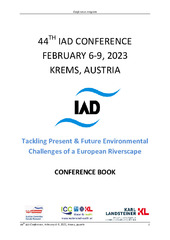Приказ основних података о документу
Occurrence of antibiotic resistance genes along gradients of faecal pollution in water and biofilm samples from the whole Danube River
| dc.creator | Schachner-Gröhs, Iris | |
| dc.creator | Kolm, Claudia | |
| dc.creator | Vierheilig, Julia | |
| dc.creator | Leopold, Melanie | |
| dc.creator | Zarfel, Gernot | |
| dc.creator | Koller, Michael | |
| dc.creator | Kittinger, Clemens | |
| dc.creator | Jakwerth, Stefan | |
| dc.creator | Linke, Rita | |
| dc.creator | Kolarević, Stoimir | |
| dc.creator | Kračun-Kolarević, Margareta | |
| dc.creator | Toth, Erika | |
| dc.creator | Farnleitner, Andreas | |
| dc.creator | Kirschner, Alexander | |
| dc.date.accessioned | 2024-03-14T15:14:57Z | |
| dc.date.available | 2024-03-14T15:14:57Z | |
| dc.date.issued | 2023 | |
| dc.identifier.uri | http://radar.ibiss.bg.ac.rs/handle/123456789/6590 | |
| dc.description.abstract | Antimicrobial resistance (AMR) represents one of the top ten global public health threats according to the WHO. The spread of resistances is no longer limited to clinical settings and the natural environment, especially aquatic ecosystems, are also strongly involved in the global spread. Holistic as well as quantitative studies are still scarce. We here present for the first time a large scale study on the Danube River regarding the distribution of AMR along different faecal pollution patterns. For this study, samples from an international sampling campaign (Joint Danube Survey 4) as well as additional seasonal samples were screened for the occurrence and origin of faecal pollution and for the concentrations of nine representative antibiotic resistance genes (ARGs). In addition to water samples also river biofilms were monitored to account for both, temporal and permanent river habitats. Analyses were amended by a set of different cultivation-based and non-cultivation-based microbiological and environmental data to explain the observed pattern in faecal pollution and ARG concentrations. Faecal pollution exists and varied strongly along the whole Danube river; hotspots could be identified downstream of metropolitan areas at which also substantial concentrations of ARGs could be detected. Quantifying concentrations of ARGs conferring resistance to different antibiotic classes revealed strong differences between the different genes. Comparing their presence in water and biofilm samples, allowed to assess how stably present these genes already are in the Danube River ecosystem. Environmental surveys are necessary to establish environmental baselines, to be able to guide future AMR monitoring as well as to enforce useful management strategies. This integrative study therefore provides first insights in the antimicrobial resistance situation in the most international river in the world and second largest river in Europe | sr |
| dc.language.iso | en | sr |
| dc.publisher | Austrian Committee - International Association for Danube Research | sr |
| dc.rights | openAccess | sr |
| dc.source | Conference Book: 44th IAD conference: Tackling Present & Future Environmental Challenges of a European Riverscape; 2023 Feb 6-9; Krems, Austria | sr |
| dc.title | Occurrence of antibiotic resistance genes along gradients of faecal pollution in water and biofilm samples from the whole Danube River | sr |
| dc.type | conferenceObject | sr |
| dc.rights.license | ARR | sr |
| dc.rights.holder | © 2023 by the Austrian Committee - International Association for Danube Research | sr |
| dc.description.other | Conference Book: 44th IAD conference: Tackling Present & Future Environmental Challenges of a European Riverscape; 2023 Feb 6-9; Krems, Austria. Austrian Committee - International Association for Danube Research; 2023. p. 25. | sr |
| dc.citation.spage | 25 | |
| dc.type.version | publishedVersion | sr |
| dc.identifier.fulltext | https://radar.ibiss.bg.ac.rs/bitstream/id/17061/2023_AbstractBook_44th_IAD_conf_Krems6.pdf | |
| dc.citation.rank | M34 | |
| dc.identifier.rcub | https://hdl.handle.net/21.15107/rcub_ibiss_6590 |

